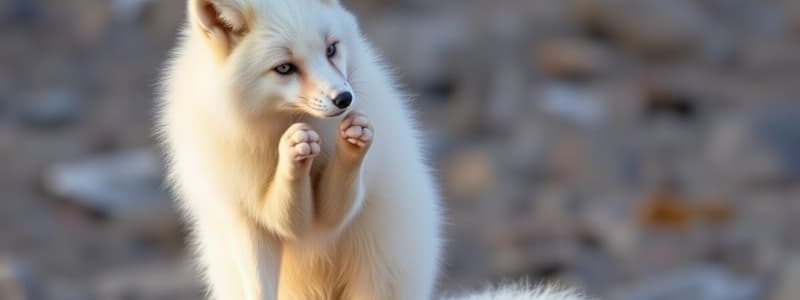Podcast
Questions and Answers
What is the species name of the arctic fox?
What is the species name of the arctic fox?
Vulpes lagopus
What are burrows?
What are burrows?
Holes or tunnels small animals use as underground nests
What is another name for a fox's tail?
What is another name for a fox's tail?
Brush
When is the mating period for arctic foxes?
When is the mating period for arctic foxes?
What color is the arctic fox's fur in the summer, and why?
What color is the arctic fox's fur in the summer, and why?
What color is the arctic fox's fur in the winter?
What color is the arctic fox's fur in the winter?
What is the arctic fox's primary prey?
What is the arctic fox's primary prey?
What are lemmings?
What are lemmings?
What is a vole?
What is a vole?
What does litter refer to in the context of arctic foxes?
What does litter refer to in the context of arctic foxes?
Where does the arctic fox inhabit?
Where does the arctic fox inhabit?
Is the arctic fox a carnivore, herbivore, or omnivore?
Is the arctic fox a carnivore, herbivore, or omnivore?
What trophic level are arctic foxes on?
What trophic level are arctic foxes on?
How many pups do arctic foxes usually have?
How many pups do arctic foxes usually have?
On average, how long are arctic foxes?
On average, how long are arctic foxes?
How long do arctic foxes live?
How long do arctic foxes live?
What unique feature helps the arctic fox hunt?
What unique feature helps the arctic fox hunt?
What is the arctic tundra like?
What is the arctic tundra like?
Is the arctic fox endangered?
Is the arctic fox endangered?
How big is the arctic fox population?
How big is the arctic fox population?
Is the arctic fox hunted for its fur?
Is the arctic fox hunted for its fur?
What is the biggest threat to the arctic fox?
What is the biggest threat to the arctic fox?
What do arctic foxes do in the winter when food is scarce?
What do arctic foxes do in the winter when food is scarce?
How fast can the arctic fox move?
How fast can the arctic fox move?
How much cold can the arctic fox endure?
How much cold can the arctic fox endure?
Flashcards are hidden until you start studying
Study Notes
Species Information
- Arctic fox scientific name: Vulpes lagopus
- Primary habitats include the arctic tundra and regions like Canada, Iceland, Greenland, Alaska, Russia, Norway, and Scandinavia.
Physical Characteristics
- Summer fur color: Gray or brown for camouflage among rocks and foliage.
- Winter fur color: White with a possible blue tint for blending in with the snow.
- Average size ranges from 2.3 to 3.5 feet in length.
Diet and Hunting
- Primary diet consists of lemmings, but also includes voles, arctic hares, and some plant matter, classifying them as omnivores.
- Unique hunting ability: Incredible hearing facilitated by wide, front-facing ears aids in locating prey beneath the snow.
Reproduction
- Mating period spans from early September to early May.
- Average litter size is 5-9 pups, but larger litters can occur.
- Lifespan in the wild is typically between 3-6 years, while they may live up to 13 years in captivity.
Population and Conservation
- Current status: Species of least concern, with a population in the hundred thousands.
- While there are concerns about endangerment, hunting pressures have decreased significantly since the late 20th century.
- Hunted for fur primarily by native Arctic peoples, but widespread hunting practices have reduced.
Threats and Competition
- Red foxes pose the most significant threat, acting as competitors for food.
Winter Behavior
- In harsh winter conditions with limited food sources, arctic foxes may scavenge from polar bears after the bears finish their kills.
Adaptations
- Extreme cold resistance: Can endure temperatures as low as -50 degrees Celsius.
- Capable of running at speeds up to 50 km per hour.
Additional Facts
- A burrow serves as an underground nest for arctic foxes, providing shelter and safety.
- The term brush refers to the arctic fox's tail.
Studying That Suits You
Use AI to generate personalized quizzes and flashcards to suit your learning preferences.




